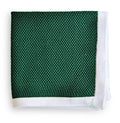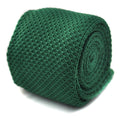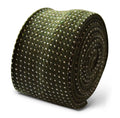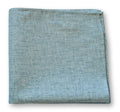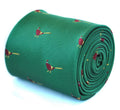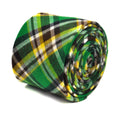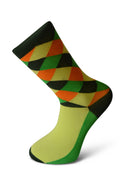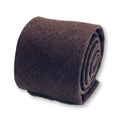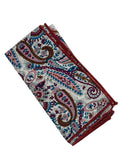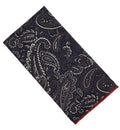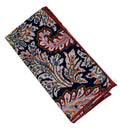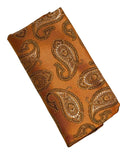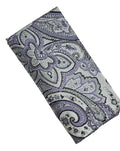How to tie a tie: 5 knots you need to know for every occasion
Posted by

You’re probably aware of how to tie a tie in one way or another– maybe the four-in-hand or the Windsor knot? But according to a German mathematician named Mikael Vejdemo-Johansson, there are more than 177,000 ways to tie a tie. Of course, the large majority of these are rather obscure and unusual. For instance, the Merovingian knot brings the thin back of the tie to the front and hangs beneath a fancy knot – and so you’ll probably never need to (or want to) know how to tie one of them.
But if you’re heading to a wedding, or are looking for an alternative knot, we’ve got 5 tie knots to get you started:
Knot #1: The Four-in-Hand (or simple knot / schoolboy knot):
This knot dates all the way back to 1856 and is named after the Four-in-Hand Club, a group of young Victorian men who would bribe coachmen to give them the reins to their horses so that they could drive them at high speeds along the roads. Although they became less raucous over time, they also popularised the necktie as a fashion piece and – in particular – the four-in-hand knot. Now, it’s become the go-to knot for men everywhere and is also a personal favourite of the Royal Family.
Suitable for:
Every day wear and – when accessorised – formal occasions. The slight asymmetry of the knot means that it’s not perfect for super formal events, but whether you’re at a wedding or the office, this knot won’t look out of place.
Not suitable for:
Wider collars, delicate tie fabrics or people with longer necks
How to tie a four-in-hand knot:

Knot #2: The Windsor
Depending on which story you listen to, the Windsor knot was either invented by the Duke of Windsor, or named after him. There’s also another rumour that George V, the Duke of Windsor’s father, invented the knot and passed it down. There’s lots of history, etiquette and – if you can believe this – controversy surrounding tie knots. In certain parts of the UK armed forces, it’s deemed inappropriate to wear a Windsor knot because the Duke of Windsor abdicated the throne
Whether you believe the Duke invented it, his father invented it or the public invented it to mimic royalty, the Windsor was designed to give a much larger, thicker knot from thinner fabrics.
Suitable for:
Ultra formal occasions and job interviews, when paired with a wide collar shirt.
Not suitable for:
Thin collars, skinny ties or relaxed settings.
How to tie a Windsor knot:

Knot #3: The Half-Windsor
There’s not really an exciting history behind this knot – it basically exists because people liked the shape of the Windsor, but not its size. (To be fair to them, the Windsor is a pretty big knot!). The half-Windsor is the perfect middle ground between the four-in-hand and the Windsor. Slightly more formal than the Four-in-hand (which, because of its familiarity, has lost a little of the class it once had) but less formal and modest than the Windsor, the half-Windsor is great for low-key weddings and job interviews.
Suitable for:
Great for thinner men who still want the elegance and sophistication of a Windsor knot.
Not suitable for:
Larger men with thicker necks, as the knot will look a bit small. Just stick to the Windsor knot, if this is you.
How to tie a half-Windsor knot:

Knot #4: The Balthus
OK, we’ve given you three fairly safe options, now for something a bit more out there.
If you’re looking for a knot that makes a statement – the Balthus is the knot for you. This knot was originally based on the knot style of the French-Polish controversial artist Balthasar Klossowski de Rola, known as Balthus, but has become popular again recently as the knot of choice for Hannibal Lector in the TV series Hannibal.
You could quite easily call this knot the quadruple-Windsor, and the knot is an absolute beast. This knot definitely requires a fair amount of confidence to pull off – it is very much a ‘look at my tie!’ knot, so make sure that you’re rocking your finest tie too. A nice paisley tie goes well with the Balthus.
Suitable for
Formal occasions where you want to make an impression.
Not suitable for:
Two-piece suits – because of the sheer amount of material used by the knot, the tip of the tie barely reaches the top of your belly button. Make sure you’re wearing a waistcoat or jumper to hide this, otherwise you’ll be getting looks, but for all of the wrong reasons.
How to tie a Balthus knot:

Knot #5: The Kelvin
The Kelvin is a nice modern twist on the four-in-hand knot, making it much more symmetrical. Named after Lord Kelvin who, while being most famous for his contributions to thermodynamics, was also an early contributor to mathematical knot theory. (Yes, really.) The Kelvin’s symmetry and somewhat nerdy history makes it the perfect knot when you’re going for the somewhat preppy look. Using the Kelvin to pair a textured tie with a check shirt is a great casual but work-place friendly combination, especially if you work in an artistic or creative environment.
Suitable for:
Upgrading the four-in-hand know without drawing too much attention to your neck.
Not suitable for:
Larger guys – the smaller knot can make your head appear disproportionately big, unfortunately.
How to tie a Kelvin knot:

To find the perfect tie to complement your knot of choice, why not check out our selection of ties? We’ve got everything from plain and spotted to paisley and tweed. And, if you’re in the adventurous mood and none of these knots quite did it for you, why not try a random knot from one of Mikael Vejdemo-Johansson’s 177,147 ties using his Tie Knot Generator...


